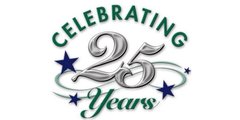Main program window
After starting the program, the QV main window will appear and the globe will be zoomed from the universe.
A world map will be plotted over the surface of the earth and all stars will be visualized at their exact location above the earth. If you enable the function “open last map view on start”, QV will start lateron in a different way and plot the last layout instead of the initial globe.
With the Topomap Germany, 1 : 25.000 scale, the QV main window may look like this:

The main window features all important elements required for operating QV:
- The main menu bar with the pull-down menus File, New, View, GPS, Options, Window and ? (= help).
- This is the Standard symbol bar with the most important functions like
 Open X-Plorer (or toggle between Xplorer and Map window),
Open X-Plorer (or toggle between Xplorer and Map window),  AutoMap mode,
AutoMap mode,  Serach for coordinates,
Serach for coordinates,  Search for names (geographic database),
Search for names (geographic database),  Units,
Units,  3D-Options,
3D-Options,  Open geographic database,
Open geographic database,  GPS Online mode (driving mode),
GPS Online mode (driving mode),  Project manager,
Project manager,  Street Routing,
Street Routing,
- This is the View symbol bar with icons for controlling the look of the map window. This symobol bar starts with icons for the sacle such as
 Zoom In,
Zoom In,  Zoom Out,
Zoom Out,  Zoom 100%,
Zoom 100%,  Zoom on selection,
Zoom on selection,  Zoom on entire map,
Zoom on entire map,  Center zoom on cursor. Further to the right icons follow adressing the chronology of commands like
Center zoom on cursor. Further to the right icons follow adressing the chronology of commands like  Undo,
Undo, Redo with command history and
Redo with command history and  Set Reference Point (bookmark). Further to the left icons for selecting maps with other scales like
Set Reference Point (bookmark). Further to the left icons for selecting maps with other scales like  Open map with larger scale,
Open map with larger scale,  Open map with smaller scale,
Open map with smaller scale,  Open another map with the same sacle. Finally some icons with various functions such as
Open another map with the same sacle. Finally some icons with various functions such as  Map overview,
Map overview,  Map legend,
Map legend,  Display map scale and
Display map scale and  Grid overlay.
Grid overlay.
- Please note that some icons may not be available if no suitable map is available or no suitable object has been selected. In case of the Roadbook Editor, the icon
 will only be available if you have purchased the corresponding plug-in or the Poweruser edition. The Street Routing icon
will only be available if you have purchased the corresponding plug-in or the Poweruser edition. The Street Routing icon  will only be available if you have purchased a NAVTRQ Routing or NAVTEQ Navi option.
will only be available if you have purchased a NAVTRQ Routing or NAVTEQ Navi option.
- At the bottom of the window the status bar which summarizes important information on the actual mouse and cursor position like the coordinates, the distance and bearing between mouse and cursor position, the magnetic offset or the name of the country. You will also find a Show in Map button there (center) and a button to switch between several crosshair designs.
- The actual window area is filled either with the map window, the overview window or the X-Plorer, depending on what you have opened. You will find a detailed description of all options in the chapter “Main Window”.
- You can open (or close) additional Toolbars in the View menu under Toolbars. Those toolbars are specialized for specific tasks and are described in the corresponding chapters below.
At the buttom of the map window, you will find the map status field which summarizes important information:
- The position of the map cursor including altitude
- The actual position of the mouse pointer including altitude
Central column
- Name of the used map
- Distance, course, altitude difference and corresponding slope in % between map cursor and mouse pointer
Right column:
Name of the used DEM (digital elevation model) and the acutual map datum
Remark: Please note that all coordinates are specified in the units according to the unit settings.
If you have enabled the display of the North arrow in the View menu, you will find a compass rose plotted in the upper left corner of the map window. In this case you will also find all details on the camera characteristics like position, altitude, speed, course, pitch and roll.
Coordinate and distance units can be changed at any time using the  icon, e.g. to miles and UTM, etc. Refer to chapter Settings for more details.
icon, e.g. to miles and UTM, etc. Refer to chapter Settings for more details.
![[Translate to English:] QuoVadis GPS](/fileadmin/_processed_/5/b/csm_QuoVadis-Logo_JTL_dadf090183.png)
